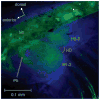The Caudal Skeleton of the Zebrafish, Danio rerio, from a Phylogenetic Perspective: A Polyural Interpretation of Homologous Structures
- PMID: 28250540
- PMCID: PMC5328193
- DOI: 10.1643/CG-14-105
The Caudal Skeleton of the Zebrafish, Danio rerio, from a Phylogenetic Perspective: A Polyural Interpretation of Homologous Structures
Abstract
The structure of the caudal skeleton of extant teleost fishes has been interpreted in two different ways. In a diural interpretation, a caudal skeleton is composed of two centra articulated with one to six hypurals. Most subsequent authors have followed this interpretation. In contrast, a polyural interpretation considers the teleost fin to be derived from a fully metameristic ancestral bauplan originally composed of a one-to-one relationship between neural arches, centra (when present), and hypurals. Three different interpretations of the identity and homology of skeletal components of the caudal skeleton of the teleost fish Danio rerio have been proposed, two from a diural perspective and one from a polyural perspective. We examine each caudal skeletal component of Danio rerio from both a developmental and phylogenetic perspective. We propose that a polyural interpretation of structures is consistent with the current interpretation of the basal neopterygian caudal fin for this model organism rather than the older diural interpretation that does not take into account the metamerism observed in caudal structures during development. The polyural interpretation suggests several shared evolutionary innovations of major clades that would remain undiscovered under the older diural naming paradigm and makes the terminology of the parts of the caudal fin of Danio rerio strictly comparable to more basal fishes.
Figures






References
-
- Arratia G. The caudal skeleton of Jurassic teleosts: a phylogenetic analysis. In: Chang M-M, Liu Y-H, Zhang G-R, editors. Early Vertebrates and Related Problems in Evolutionary Biology. Science Press; Beijing: 1991. pp. 249–340.
-
- Arratia G. The Clupeocephala re-visited: analysis of characters and homologies. Revista de Biología Marina Oceanografía. 2010;45:635–657.
-
- Arratia G. Morphology, taxonomy, and phylogeny of Triassic pholidophorid fishes (Actinopterygii, Teleostei) Journal of Vertebrate Paleontology. 2013;33(Supplement 6):1–138. Memoir 13.
-
- Arratia G, Bagarinao T. Developmental morphology of the skeleton of Chanos chanos (Ostario-physi, Gonorynchiformes) In: Grande T, Poyato-Ariza F-J, Diogo R, editors. A Comprehensive Review of Gonorynchiformes and of Ostariophysan Relationships. Science Publishers Inc; Enfield, New Hampshire: 2010. pp. 73–106.
-
- Arratia G, Schultze HP. Reevaluation of the caudal skeleton of certain actinopterygian fishes: III. Salmonidae. Homologization of caudal skeletal structures. Journal of Morphology. 1992;214:187–249. - PubMed
Grants and funding
LinkOut - more resources
Full Text Sources
Molecular Biology Databases
